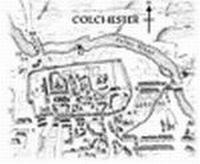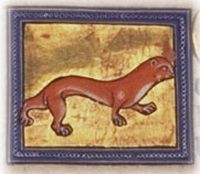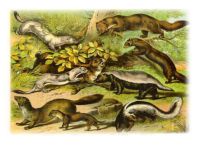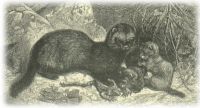Colchester, 1189 AD
 The earliest mention I could find about mustelids in Medieval England was a reference to Colchester, a town in Essex.
The earliest mention I could find about mustelids in Medieval England was a reference to Colchester, a town in Essex.
When Henry II died, Richard the Lionheart came to the throne in 1189. That same year Colchester received the first known royal charter from King Richard, which gave the borough the foundations of self-government.
Among other things was the right to hunt fox, hare or polecat within the liberty (borough bounds).
King Richard went on to finance the Third Crusades by charging everyone a ‘Saladin tithe’ as a means of adding to the coffers of his war chest.
Hah! Imagine the outcry if our government were to charge us all an ‘Osama tithe’ so that they can pay for “the global struggle against violent extremism”!! 
Aberdeen Bestiary, c 1200 AD
 Medieval bestiaries were based on early Greek and Latin texts and were lavishly illustrated, the most well known of one being The Aberdeen Bestiary.
Medieval bestiaries were based on early Greek and Latin texts and were lavishly illustrated, the most well known of one being The Aberdeen Bestiary.
This Bestiary was written in the North Midlands of England around 1200 AD and consists of 104 folios.
The picture of the weasel is Folio 23v, with the description:
The cat, a catcher of mice, mice; the weasel, who hunts snakes and gives birth through its ear or mouth.
The folio on the weasel gives us one of the earliest insights to an animal which could well have been the polecat/ferret, as well as keeping alive the weird impression, found both in the Epistle of Barnabas and The Metamorphoses, about weasels conceiving through the mouth.
“It hunts snakes and mice. There are two kinds of weasel. One, of very different size from the other, lives in the forest. The Greeks call these ictidas; the other roams around in houses. Some say that weasels conceive through the ear and give birth through the mouth; others say, on the contrary, that they conceive through the mouth and give birth through the ear; it is said, also, that they are skilled in healing, so that if by chance their young are killed, and their parents succeed in finding them, they can bring their offspring back to life.
“Weasels signify the not inconsiderable number of people who listen willingly enough to the seed of the divine word but, caught up in their love of wordly things, ignore it and take no account of what they have heard.”
Queen Mary’s Psalter, 14th Century AD
A Psalter is a collection of psalms for devotional or liturgical use during the Middle Ages.
Many psalters had fabulous illustrations and Queen Mary’s Psalter actually has drawings of weasels which were shown to “conceive through the mouth and give birth through the ear“.

This is obviously a hangover from Greek mythology days, like what happened to Galanthis.
The Bard and his Mustelids, 1564-1616 AD
 William Shakespeare, who was born in Stratford-upon-Avon in 1564, was around during the reigns of both Elizabeth I and James I, and was a favorite of both monarchs.
William Shakespeare, who was born in Stratford-upon-Avon in 1564, was around during the reigns of both Elizabeth I and James I, and was a favorite of both monarchs.
He is without a doubt the most famous literary figure of that time and several of his plays have references to mustelids sprinkled through them!
There is a reference to a polecat in The Merry Wives of Windsor where Mistress Quickly states “Polecats! There are fairer things than polecats, sure.”
I respectfully would challenge Mistress Quickly’s opinion for I am sure we would all agree that there are few things fairer. 
And you’ll find in another part of Henry V there is a reference to “the weasel Scot” who comes sneaking and sucks her princely eggs!
You’ll find that old Will enjoys talking about weasels sucking eggs because in As You Like It, a chap called Jaques reckons he “… can suck melancholy out of a song as a weasel sucks eggs“.
In Cymbeline, women are said to be “… as quarrelous as the weasel …“. Hrumph! If Shakespearel were around now, I would certainly take issue with him about that statement. Quarrelous, indeed!! 
Then in Hamlet, the Prince of Denmark looks at a cloud and thinks it looks like a weasel (very fertile imagination, Hamlet old boy).
And last but not least, in The First Part of Henry IV, Lady P reckons that “A weasel hath not such a deal of spleen …“.
Hmmm, you reckon it mean that the weasel doesn’t vent its spleen but it’s just a sweet little pussycat?
So with all the descriptions in Shakespeare’s plays, we must assume that the medieval English folk had quite a lot to do with weasels, polecats and ferrets in their day.
Well, that’s my take on it anyhow and I’m sticking to it! Heh heh.
Miscellaneous Mustelid Information
 A book called Of Savage Beasts and Vermin, written in 1577, had quite a large section on “… other vermin, as the polecat, the miniver, the stote, fulmart, squirrel, fitchew, and such like, which Cardan includeth under the word Mustela: …”
A book called Of Savage Beasts and Vermin, written in 1577, had quite a large section on “… other vermin, as the polecat, the miniver, the stote, fulmart, squirrel, fitchew, and such like, which Cardan includeth under the word Mustela: …”
The author also refers to the “martern” [sic] as “a beast of the chase” and seemed to think that the marterns and beavers in England were comparable to those found in Balascham, in Persia.

Then in 1587, another book called Of Our English Dogs and Their Qualities, had a paragraph in it about how hunters had dogs called harriers, “whose game is the fox, the hare, the wolf (if we had any), hart, buck, badger, otter, polecat, lopstart, weasel, conie, etc.”
In English villages during 1590 it was the churchwarden’s duty to keep control over vermin. Then people were given two shillings for killing otters!
Later, 2/6d was the going bounty for sparrow heads, for weasels and stoats, while in 1769 one could get “three polecats for one shilling“.
Egad! That’s not cricket!!

Deprecated: str_contains(): Passing null to parameter #1 ($haystack) of type string is deprecated in /home4/kitchast/public_html/wp-includes/comment-template.php on line 2681